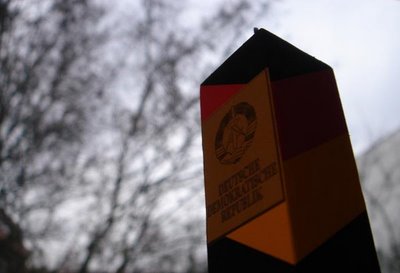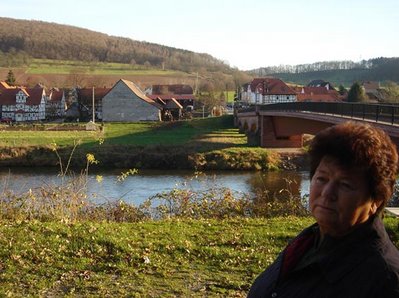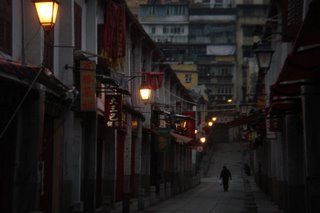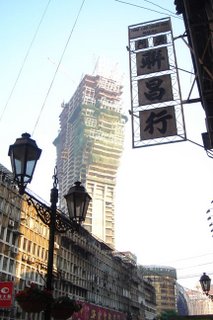(From a Border Discussion at the Schifflersgrund Grenzmuseum and preliminary oral histories collected from Lindewerra,Thüringen, December 2006*)
 Remains of the DDR border viewed from Hanstein Castle, Bornhagen,Thüringen
Remains of the DDR border viewed from Hanstein Castle, Bornhagen,ThüringenThe history of Germany’s ideological boundary (1949-1990) that separated the former BRD (Bundes Republik Deutschland – better known as West Germany) and the DDR (Deutsche Demokratische Republik) as the world’s most absurd form of human partitioning is now well known. Most people will be quite familiar with the history Berlin’s ‘Schandmauer’ and the much- visited Checkpoint Charlie.
Lesser known to non-Germans is the previous 1,400 km stretching border, which ran throughout the countryside. When Germany’s partitioning into different occupation zones (British, French, American and Soviet) began in July 1945, they naturally chopped-up the countryside according to Germany’s old state borders. One such border site remains well preserved for historical significance in Schifflersgrund at the Thüringen-Hessen boundary.
 DDR Borderpoles
DDR BorderpolesSWAPPING FATES
The establishment of the American – Soviet occupation zone boundary (known as the ‘Whiskey-Vodka linie’) that followed the old German state borders of Hessen & Bayern (both under U.S. occupation) and Thüringen (under Soviet occupation) posed one major problem. The Americans heavily depended on the north-to-south German railway stretching from Hamburg down to München in order to keep the logistical lifeline running for its troops in the far south. Problematic was the fact that the rail ran through a small stretch of Soviet-occupied Thüringen. Frequent harrassing of U.S. supply trains by Soviet troops drove the Americans to renegotiate the boundary with the Soviets in order to bring the railway under total U.S. control. In September 1945 the Soviet Army agreed for a territorial exchange, and this particular chunk of Thüringen territory through which the railway ran was officially transferred to U.S.-occupied Hessen. In return, the Soviets demanded an equal portion of Hessen to be annexed over to Soviet-controlled Thüringen.
It seemed to be a fair and nice deal on paper.
By the stroke of a pen, four villages in Hessen suddenly woke up one morning finding themselves under Soviet occupation (and the future DDR), while two Thüringian villages struck ‘luck’ by being handed over to ‘free’ U.S.-occupied Germany.
 A border memorial stone erected near Bornhagen, littered with some recent pro-DDR grafitti
A border memorial stone erected near Bornhagen, littered with some recent pro-DDR grafittiLINDEWERRA
Other villages, like Lindewerra, simply found out in 1949 that they were to be separated forever under the new DDR from their jobs, families and farming grounds on the other side of the once fluid borders.
 Gerlinde (69) looking across to Lindewerra, where the Werra river previoulsy separated the DDR from BRD
Gerlinde (69) looking across to Lindewerra, where the Werra river previoulsy separated the DDR from BRDGerlinde Kohler (69) remembers, “we were still allowed to move back and forth with permission over the boundary before 1949. Stricter border patrols were introduced soon after, though it was still possible to play hide-and-seek with the guards as locals were still able to use old footpaths into the surrounding forests which were less-frequently patrolled.”
People were not allowed to migrate, though those still holding jobs in the West were given limited permission to cross the Werra river until 1952. Gerlinde’s father used to commute weekly between Lindewerra (in DDR) and his working place in Oberrieden (in BRD). Until one day in 1952, the DDR border guards stopped the rivercrossing boat from running. Gerlinde´s father was stuck on the other side while his family was trapped in Lindewerra. Sensing that the border was going to be shut forever, he managed one early morning to smuggle his family out in time. With DDR border guards close at her heels, Gerlinde managed to swim across just in time. Her grandparents, however, stayed behind. She never saw them again.
"There was a short period of time when we would stand on the riverbank and exchange messages to the other side." Soon after, the DDR even prohibited its citizens from waving or smiling to the West.
GERMAN QUALITIES
“Germans are always the best in what they do” said Oliver Rau, a local Thüringian political scientist, “ and this included the DDR in its border management.”
As the border was rather meant to keep East Germans as hostages inside, the way fences were erected was an ‘art’ in itself. The DDR government built its border fences approximately 10 to 20 meters inside and away from the actual boundary. A deliberate tactic to give east German escapees a false sense of security once they managed to climb over the fence (many escapees committed the error of resting or taunting border guards once they climbed over), this 10 – 20 meter space between the fence and the actual DDR-BRD boundary was intended to function as a last and easy shooting zone for DDR border guards.
 The intact border fence at Schifflersgrund
The intact border fence at SchifflersgrundAfter the opening of the borders in late 1989 and Germany`s reunification soon thereafter, most physical differences between villages in border areas dissapeared., though the landscape is still left scarred with barren lands where the shooting zones and fences once menacingly stood. While eastern Germans like Willi Stüber (79), would rather like to erase the 40-year DDR rule from his memory, in no way does it imply a wholesale acceptance of free fight capitalism of the West. “Life was hard back then, but it still is now”, said Willi, “though less worse than it used to be.”
 Willi Stüber (79) remembers
Willi Stüber (79) remembersIt was simply the repression and partitioning they hated the most.
DL
* Thanks to Chris Oesterheld
Gerlinde Köhler-Brill, Willi Stüber
Wolfgang Ruske, Viktor Speiser & Oliver Rau (Grenzmuseum staff)
and Ronald Gundlach (Burgermeister of Bad Sooden-Allendorf)
 Macau dawn at Rua da Felicidade
Macau dawn at Rua da Felicidade

 A Pinoy ad....and problem.
A Pinoy ad....and problem. Signs of Indon presence in Macau
Signs of Indon presence in Macau Echoes of Dear Chairman, once influential in Macau during the 1960s
Echoes of Dear Chairman, once influential in Macau during the 1960s
 Remains of the DDR border viewed from Hanstein Castle, Bornhagen,Thüringen
Remains of the DDR border viewed from Hanstein Castle, Bornhagen,Thüringen DDR Borderpoles
DDR Borderpoles A border memorial stone erected near Bornhagen, littered with some recent pro-DDR grafitti
A border memorial stone erected near Bornhagen, littered with some recent pro-DDR grafitti Gerlinde (69) looking across to Lindewerra, where the Werra river previoulsy separated the DDR from BRD
Gerlinde (69) looking across to Lindewerra, where the Werra river previoulsy separated the DDR from BRD The intact border fence at Schifflersgrund
The intact border fence at Schifflersgrund Willi Stüber (79) remembers
Willi Stüber (79) remembers